Mar 27 2020, Friday
Bokehlicious Selfies
I signed up for the excellent fastai MOOC recently, and one of the project ideas I had was the idea of adding bokehs to selfies using Deep learning. Most phones have a not so great selfie (front-side) camera and therefore this idea has some merits.
Google Photos does something like this and it's quite magical when it works. So i wanted to experiment with a simple pipeline which could be used to add a bokeh to a selfie that did not have one.
Breaking down the problem
One idea I had was to be able to use image-segmentation to identify and build a segmentation mask around the person in the image. For this I used the excellent torchvision.models.detection.maskrcnn_resnet50_fpn pretrainted model. This model has been trained with the COCO dataset, and therefore is pretty great out of the box for the given use-case.
Once we have a segmentation mask of the person in the image; we could then use that to split the image into a foreground or a subject, and the rest of it would be background. I could then use image convolution to create a bokeh effect on the background image and merge it with the subject to give it a nice pop.
One key thing to remember is that the merged image is only as good as the segmentation mask, but given I am restricting the input image type to a portrait selfie this works most of the time.
Let's write some code
The Bokeh Effect
I read this incredible article on how to simulate a bokeh effect. I then adapted the idea and wrote a quick Python implementation using some helpers from OpenCV.
Let's start with our imports.
import cv2
import math
import numpy as np
import matplotlib.pyplot as plt
plt.rcParams["figure.figsize"]= (10,10)
np.set_printoptions(precision=3)We need to build a convolution kernel which can produce a bokeh effect. The idea here is to take a gaussian kernel with a large standard-deviation and multiply it with a simple binary mask to emphasize the effect.
triangle = np.array([
[0, 0, 0, 0, 0, 0, 0, 0, 0, 0, 0],
[0, 0, 0, 0, 0, 1, 0, 0, 0, 0, 0],
[0, 0, 0, 0, 1, 1, 1, 0, 0, 0, 0],
[0, 0, 0, 0, 1, 1, 1, 0, 0, 0, 0],
[0, 0, 0, 1, 1, 1, 1, 1, 0, 0, 0],
[0, 0, 0, 1, 1, 1, 1, 1, 0, 0, 0],
[0, 0, 1, 1, 1, 1, 1, 1, 1, 0, 0],
[0, 0, 1, 1, 1, 1, 1, 1, 1, 0, 0],
[0, 1, 1, 1, 1, 1, 1, 1, 1, 1, 0],
[0, 1, 1, 1, 1, 1, 1, 1, 1, 1, 0],
[1, 1, 1, 1, 1, 1, 1, 1, 1, 1, 1],
], dtype='float')
mask = triangle
kernel = cv2.getGaussianKernel(11, 5.)
kernel = kernel * kernel.transpose() * mask # Is the 2D filter
kernel = kernel / np.sum(kernel)
print(kernel)This produces something like:
[[0. 0. 0. 0. 0. 0. 0. 0. 0. 0. 0. ]
[0. 0. 0. 0. 0. 0.016 0. 0. 0. 0. 0. ]
[0. 0. 0. 0. 0.018 0.018 0.018 0. 0. 0. 0. ]
[0. 0. 0. 0. 0.02 0.02 0.02 0. 0. 0. 0. ]
[0. 0. 0. 0.02 0.021 0.021 0.021 0.02 0. 0. 0. ]
[0. 0. 0. 0.02 0.021 0.022 0.021 0.02 0. 0. 0. ]
[0. 0. 0.018 0.02 0.021 0.021 0.021 0.02 0.018 0. 0. ]
[0. 0. 0.017 0.019 0.02 0.02 0.02 0.019 0.017 0. 0. ]
[0. 0.013 0.015 0.017 0.018 0.018 0.018 0.017 0.015 0.013 0. ]
[0. 0.012 0.013 0.015 0.016 0.016 0.016 0.015 0.013 0.012 0. ]
[0.008 0.01 0.011 0.012 0.013 0.013 0.013 0.012 0.011 0.01 0.008]]Let's try the kernel. First, lets load the input image:
# Credit for the image: https://fixthephoto.com/self-portrait-ideas.html
image = cv2.imread('images/selfie-1.jpg')
image = cv2.cvtColor(image, cv2.COLOR_BGR2RGB)
plt.imshow(image)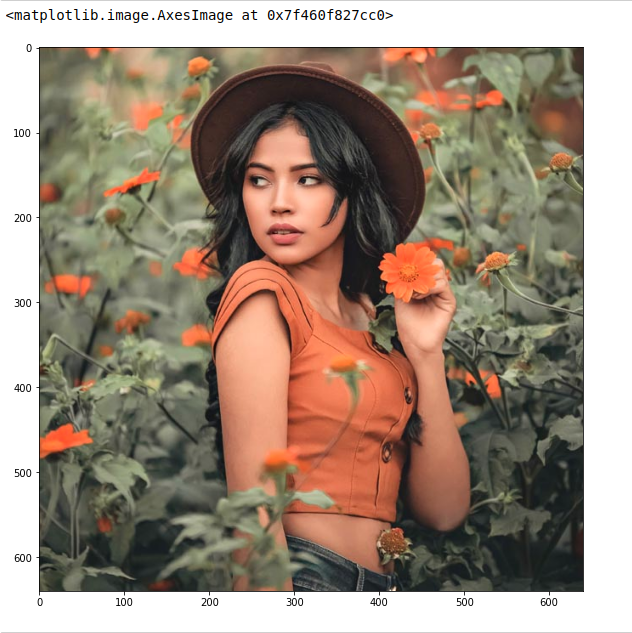
Now, let's define the actual bokeh function that applies the kernel.
def bokeh(image):
r,g,b = cv2.split(image)
r = r / 255.
g = g / 255.
b = b / 255.
r = np.where(r > 0.9, r * 2, r)
g = np.where(g > 0.9, g * 2, g)
b = np.where(b > 0.9, b * 2, b)
fr = cv2.filter2D(r, -1, kernel)
fg = cv2.filter2D(g, -1, kernel)
fb = cv2.filter2D(b, -1, kernel)
fr = np.where(fr > 1., 1., fr)
fg = np.where(fg > 1., 1., fg)
fb = np.where(fb > 1., 1., fb)
result = cv2.merge((fr, fg, fb))
return result
result = bokeh(image)
plt.imshow(result)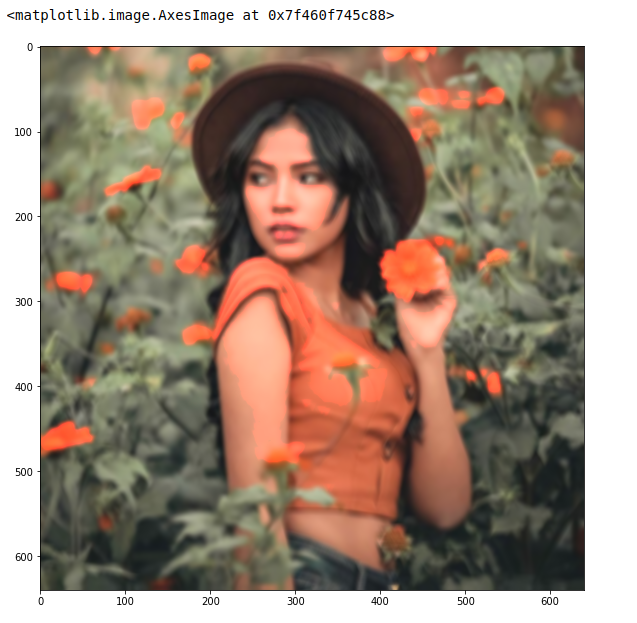
We now have a method that can generate a bokeh effect for a given image.
Image Segmentation
We now need to use the torchvision.models.detection.maskrcnn_resnet50_fpn pretrained model to segment the above image to split into foreground & background. Let's do that.
import torch
import torchvision
model = torchvision.models.detection.maskrcnn_resnet50_fpn(pretrained=True)
model.eval()
image = cv2.imread('images/selfie-1.jpg')
image = cv2.cvtColor(original, cv2.COLOR_BGR2RGB) # OpenCV uses BGR by default
image = image / 255. # Normalize image
channels_first = np.moveaxis(image, 2, 0) # Channels first
# The pre-trained model expects a float32 type
channels_first = torch.from_numpy(channels_first).float()
prediction = model([channels_first])[0]
scores = prediction['scores'].detach().numpy()
masks = prediction['masks'].detach().numpy()
mask = masks[0][0]
plt.imshow(masks[0][0])This produces a segmentation-mask which looks like:
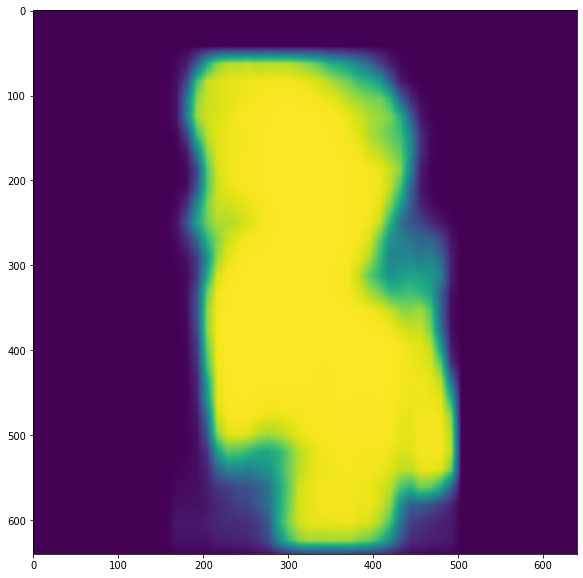
Splitting & Merging
Now that we have a segmentation-mask we can split the image into foreground and background like so:
inverted = np.abs(1. - mask)
r,g,b = cv2.split(image)
mr = r * mask
mg = g * mask
mb = b * mask
subject = cv2.merge((mr, mg, mb))
ir = r * inverted
ig = g * inverted
ib = b * inverted
background = cv2.merge((ir, ig, ib))
subject = np.asarray(subject * 255., dtype='uint8')
plt.imshow(subject)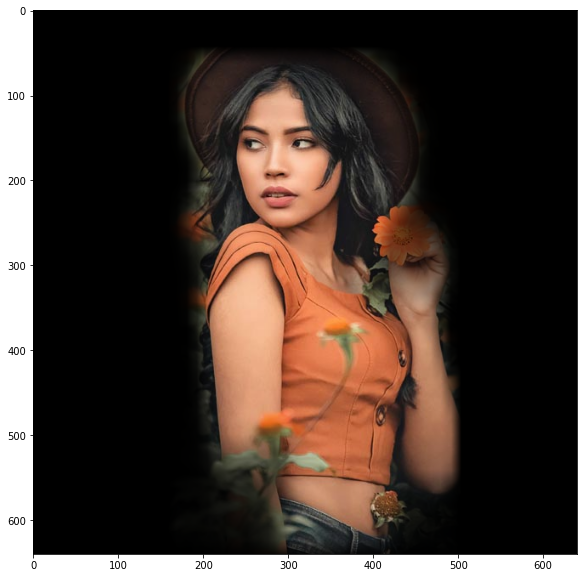
Let's now apply the bokeh effect on the background image and them merge both images.
background_bokeh = bokeh(np.asarray(background * 255, dtype='uint8'))
background_bokeh = np.asarray(background_bokeh * 255, dtype='uint8')
combined = cv2.addWeighted(subject, 1., background_bokeh, 1., 0)
plt.imshow(combined)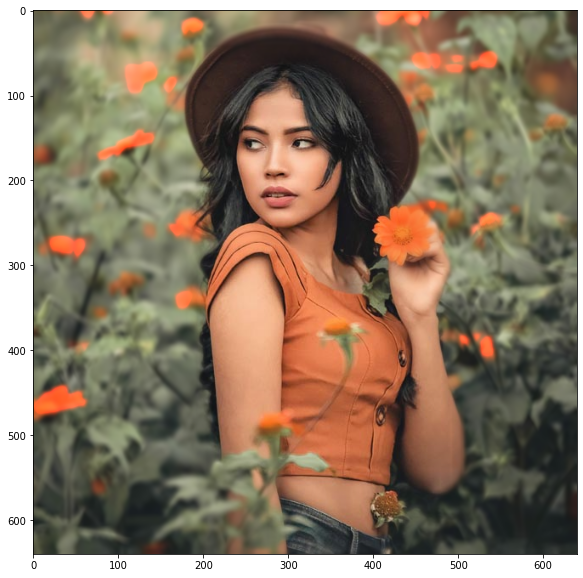
Conclusion
Deep learning is magical for applications like these. I hope you enjoyed reading the article.